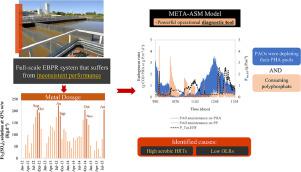Water Research ( IF 11.4 ) Pub Date : 2020-09-09 , DOI: 10.1016/j.watres.2020.116398 Jorge M M Santos 1 , António Martins 2 , Sara Barreto 2 , Leiv Rieger 3 , Maria Reis 1 , Adrian Oehmen 4

|
This study evaluates the predictive capacity of the META-ASM model, a new integrated metabolic activated sludge model, in describing the long-term performance of a full-scale enhanced biological phosphorus removal (EBPR) system that suffers from inconsistent performance. In order to elucidate the causes of EBPR upsets and troubleshoot the process accordingly, the META-ASM model was tested as an operational diagnostic tool in a 1336-day long-term dynamic simulation, while its performance was compared with the ASM-inCTRL model, a version based on the Barker & Dold model. Overall, the predictions obtained with the META-ASM without changing default parameters were more reliable and effective at describing the active biomass of polyphosphate accumulating organisms (PAOs) and the dynamics of their storage polymers. The primary causes of the EBPR upsets were the high aerobic hydraulic retention times (HRTs) and low organic loading rates (OLRs) of the plant, which led to periods of starvation. The impact of these factors on EBPR performance were only identified with the META-ASM model. Furthermore, the first signs of process upsets were predicted by variations in the aerobic PAO maintenance rates, suggesting that the META-ASM model has potential to provide an early warning of process upset. The simulation of a new viable operational strategy indicated that troubleshooting the process could be achieved by reducing the aerated volume by switching off air in the first half of the aeration tank. In this new strategy, the META-ASM model predicted a simultaneous improvement in the biological phosphorus (P) and nitrogen (N) removal due to the enhancement of the hydrolysis and fermentation of the mixed liquor sludge in the new unaerated zone, which increased the availability of volatile fatty acids (VFAs) for PAOs. This study demonstrates that the META-ASM model is a powerful operational diagnostic tool for EBPR systems, capable of predicting and mitigating upsets, optimising performance and evaluating new process designs.
中文翻译:

使用新型代谢ASM模型对大型EBPR植物进行长期仿真,并将其用作诊断工具。
这项研究评估了META-ASM模型(一种新的综合代谢活性污泥模型)的预测能力,该模型描述了性能不一致的全面增强型生物除磷(EBPR)系统的长期性能。为了阐明EBPR异常的原因并相应地排除故障,在1336天的长期动态模拟中,将META-ASM模型作为一种操作诊断工具进行了测试,并将其性能与ASM-inCTRL模型进行了比较,基于Barker&Dold模型的版本。总体而言,在不更改默认参数的情况下,使用META-ASM获得的预测在描述聚磷酸盐蓄积生物(PAO)的活性生物量及其存储聚合物的动力学方面更为可靠和有效。EBPR失调的主要原因是植物的高需氧水力停留时间(HRT)和低有机负荷率(OLR),从而导致饥饿期。这些因素对EBPR性能的影响只能通过META-ASM模型确定。此外,过程不适的最初迹象是通过有氧PAO维持率的变化来预测的,这表明META-ASM模型具有提供过程不适早期预警的潜力。新的可行操作策略的模拟表明,可以通过关闭曝气池前半部分的空气来减少加气量,从而对过程进行故障排除。在这个新策略中 META-ASM模型预测,由于新的非曝气区混合液污泥的水解和发酵作用的增强,生物磷(P)和氮(N)的去除同时得到改善,这增加了挥发性脂肪酸的利用率(VFA)的PAO。这项研究表明,META-ASM模型是EBPR系统的强大运行诊断工具,能够预测和缓解故障,优化性能并评估新的工艺设计。











































 京公网安备 11010802027423号
京公网安备 11010802027423号